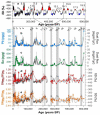Lead Isotopic Constraints on the Provenance of Antarctic Dust and Atmospheric Circulation Patterns Prior to the Mid-Brunhes Event (~430 kyr ago)
- PMID: 35807454
- PMCID: PMC9268056
- DOI: 10.3390/molecules27134208
Lead Isotopic Constraints on the Provenance of Antarctic Dust and Atmospheric Circulation Patterns Prior to the Mid-Brunhes Event (~430 kyr ago)
Abstract
A lead (Pb) isotopic record, covering the two oldest glacial-interglacial cycles (~572 to 801 kyr ago) characterized by lukewarm interglacials in the European Project for Ice Coring in Antarctica Dome C ice core, provides evidence for dust provenance in central East Antarctic ice prior to the Mid-Brunhes Event (MBE), ~430 kyr ago. Combined with published post-MBE data, distinct isotopic compositions, coupled with isotope mixing model results, suggest Patagonia/Tierra del Fuego (TdF) as the most important sources of dust during both pre-MBE and post-MBE cold and intermediate glacial periods. During interglacials, central-western Argentina emerges as a major contributor, resulting from reduced dust supply from Patagonia/TdF after the MBE, contrasting to the persistent dominance of dust from Patagonia/TdF before the MBE. The data also show a small fraction of volcanic Pb transferred from extra-Antarctic volcanoes during post-MBE interglacials, as opposed to abundant transfer prior to the MBE. These differences are most likely attributed to the enhanced wet removal efficiency with the hydrological cycle intensified over the Southern Ocean, associated with a poleward shift of the southern westerly winds (SWW) during warmer post-MBE interglacials, and vice versa during cooler pre-MBE ones. Our results highlight sensitive responses of the SWW and the associated atmospheric conditions to stepwise Antarctic warming.
Keywords: EPICA Dome C ice core; Mid-Brunhes Event; dust and volcanic sources; isotope mixing model; lead isotopes; southern westerly winds.
Conflict of interest statement
The authors declare no conflict of interest.
Figures




References
-
- Masson-Delmotte V., Stenni B., Pol K., Braconnot P., Cattani O., Falourd S., Kageyama M., Jouzel J., Landais A., Minster B., et al. EPICA Dome C record of glacial and interglacial intensities. Quat. Sci. Rev. 2010;29:113–128. doi: 10.1016/j.quascirev.2009.09.030. - DOI
MeSH terms
Substances
Grants and funding
LinkOut - more resources
Full Text Sources

